WASTEWATER STABILIZATION LAGOON PROCESS Prepared by Michigan Department

WASTEWATER STABILIZATION LAGOON PROCESS Prepared by Michigan Department of Environmental Quality Operator Training and Certification Unit

Waste Stabilization Lagoons A carefully designed structure constructed to contain and to facilitate the operation and control of a complex process of treating or stabilizing wastewater.


Typical Lagoon System #1 Influent #3 #2 Effluent

WASTEWATER Water used to carry waste products away from homes, schools, commercial establishments, and industrial enterprises.

WASTE STABILIZATION LAGOON In a Waste Stabilization Lagoon the Components in the Wastewater are Changed so that there is Little or No Additional Change Purpose: Provide for the Operation and Control of Complex Process “Stabilizing” Components Under Control Minimizing Hazards when Discharged

WASTE STABILIZATION LAGOON In a Waste Stabilization Lagoon the Components in the Wastewater are Changed so that there is Little or No Additional Change Operators Responsibility: Ensure Efficient Operation Protect Environment Protect Human Health

TREATMENT PROCESS

Waste Stabilization Lagoons “Treatment” Process Natural Process Same Process Which Occurs in a Natural Pond or Lake Under Controlled Conditions

Waste Stabilization Lagoons Natural Process Same as Mechanical Plants Carefully Designed and Constructed Must Be Operated Properly Must Be Understood

Waste Stabilization Lagoons “The Process” Involves: Physical Processes Chemical Processes and Biological Processes

Physical Processes Evaporation Seepage Gas Exchange Sedimentation U. V. Radiation SOLIDS

Chemical Processes Inorganic Activity Precipitation Formation

Wastewater “Treatment” Process Mostly BIOLOGICAL *BACTERIA*

BACTERIA Types Aerobic Bacteria that can use only oxygen that is “free” or not chemically combined. Anaerobic Bacteria that can live in the absence of “free” oxygen. Facultative Bacteria that use either “free” or combined oxygen.

Zones in a Lagoon AEROBIC FACULTATIVE ANAEROBIC

Zonal Relationships in a Lagoon SUN O 2 Aerobic Zone Dike O 2 (Dissolved Oxygen Present) Facultative Zone Anaerobic Zone (No Dissolved Oxygen Present) Sludge Influent Sludge

Zonal Differences Environments Bacteria Activities

ANAEROBIC ZONE Sedimentation SOLIDS Stabilization Organics Organic Acids Bacteria Organic Acids Carbon Dioxide (CO 2) Ammonia (NH 3) Hydrogen Sulfide (H 2 S) Methane (CH 4)

ANAEROBIC ZONE Sedimentation SOLIDS Stabilization Not All Of the Settled Solids Will Be Broken Down. The Sludge Layer Will Increase Slowly Over the Life of the Lagoon

AEROBIC ZONE Bacteria Use Soluble Organics Influent Anaerobic Zone Respiration

RESIPRATION Organic Compounds CH 2 O + Oxygen + O 2 Carbon Dioxide CO 2 + Water + H 2 O

Wastewater New Cells Slime Layer Oxygen Food Storage Cell Membrane Enzymes (Absorption) Soluble Organics Adsorbed Particle NH 3 CO 2 H 2 O

FACULTATIVE ZONE Organisms Utilize Dissolved Oxygen or Combined Oxygen Adapt to Changing Conditions Continue Decomposition During Changing Conditions

Zonal Relationships in a Lagoon SUN O 2 Aerobic Zone Dike O 2 (Dissolved Oxygen Present) Facultative Zone Anaerobic Zone (No Dissolved Oxygen Present) Sludge Influent Sludge

Importance of Sufficient Oxygen Efficient Treatment Preventing Odors

Sources of Oxygen ABSORPTION from ATMOSHERE SUN PHOTOSYNTHESIS O 2

PHOTOSYNTHESIS A Process in which PLANTS Utilize Sunlight and Chlorophyll to Convert Carbon Dioxide and Inorganic Substances to OXYGEN and Additional Plant Material

OXYGEN SOURCES Surface Aeration Provides 6 Pounds per Acre per Day At Lagoon D. O. of 2. 0 mg/L Temperature Permitting 8. 0 mg/L Algae (Photosynthesis) Provides 100 Pounds per Acre per Day Each 60 Pounds of Algae Produce 100 pounds Oxygen

SUN Symbiotic Cycle ALGAE Photosynthesis CARBON DIOXIDE OXYGEN Respiration BACTERIA

Zonal Relationships in a Lagoon SUN O 2 Aerobic Zone Dike O 2 (Dissolved Oxygen Present) Facultative Zone Anaerobic Zone (No Dissolved Oxygen Present) Sludge Influent Sludge

ACTIVITY IN FACULTATIVE PONDS Algae CO 2 Dead Cells Anaerobic Bacteria Acid Formers Aerobic Bacteria By-Products Methane Formers

Algae and Aerobic Bacteria Influent Facultative Bacteria Anaerobic Bacteria Effluent

FACTORS THAT AFFECT THE TREATMENT PROCESS Influence of Wind Adds Oxygen Increases Mixing Must Be Controlled By Minimizing Accumulations of Material On, In, or Around the Lagoon

FACTORS THAT AFFECT THE TREATMENT PROCESS Influence of Light SUN Photosynthesis Disinfection Must Be Controlled By Minimizing Accumulations of Material On, In, or Around the Lagoon

FACTORS THAT AFFECT THE TREATMENT PROCESS Influence of Temperature Rate of Bacterial Activity Aerobic Facultative Anaerobic O 2 Growth of Algae D. O. Saturation Must Be Considered

FACTORS THAT AFFECT THE TREATMENT PROCESS Daily Fluctuations SUN Temperature Dissolved Oxygen Aerobic Facultative Anaerobic O 2 CO 2 p. H Must Be Considered

SEASONAL VARIATIONS Summer To Fall Maximum Algae And Protozoan Growth Maximum Bacterial Oxidation CO 2 Light High Temp Phosphorus Organic Nitrogen Sludge Layer High Algae Vol. High D. O. Low B. O. D. Alkaline p. H Low NH 3 -N Low Soluble P No Odors

SEASONAL VARIATIONS Winter To Early Spring Low Algae Vol. Low D. O. High B. O. D. Near p. H 7 High NH 3 -N High Soluble P Possible Odors Reduced Light Low Temp Minimum Bacterial Oxidation CO 2 Minimum Algae And Protozoan Growth Sludge Layer Phosphorus

SEASONAL VARIATIONS Spring and Fall Transition Periods Optimum for Discharging Within Permit Limits High Stream Flows - Dilution High D. O. - Lagoon and Receiving Stream Minimal Human Contact

ADVANTAGES of LAGOON SYSTEMS 1. Economical to Construct & Operate. 2. Low Monitoring & Control Requirements. 3. Rapid Recovery from “Shock” Loads. 4. Low Energy & Chemical Usage. 5. Low Mechanical Failure. 6. Minimal Sludge Disposal. 7. Long Life.

DISADVANTAGES of LAGOON SYSTEMS 1. Large Land Usage. 2. Low Control Options. 3. Operations Dependant on Climate. 4. Often High Suspended Solids. 5. Seasonal Odors. 6. Possible Ground Water Contamination. 7. Not Good In High Loading Situations.

RESULTS of PROCESS Public Health Protected Pathogens Removed Environment Protected Characteristics of Wastewater Changed End Products Stable Process Itself Is Not Offensive


GOOD RESULTS IF Process Is In Balance Properly Designed Facility Process Is Controlled System Is Maintained

Waste Stabilization Lagoons A carefully designed structure constructed to contain and to facilitate the operation and control of a complex process of treating or stabilizing wastewater.

One Very Important Tool of Design and Operation Is The Ability and Use of Series or Parallel Flow Through the System

Series 2 1 OR Parallel 1 2

Typical Lagoon System #1 #3 X Influent Effluent X X #2 SERIES OPERATION

Typical Lagoon System #1 #3 Influent Effluent X X #2 PARALLEL OPERATION

Series 2 1 Placing Majority of Load on First Cell Summer Operation Parallel 1 2 Dividing Organic Load Between At Least Two Cells Winter Operation

Loading Amount Applied to the Treatment Process Related to the SIZE of the System For Lagoons Surface Area of the System

Loading Amount Applied to the Treatment Process Population Loading Hydraulic Loading Organic Loading

POPULATION LOADING Number of Persons per Acre = Population Served (persons) Area of Lagoon (Acres) General 50 to 500 Persons per Acre Michigan 100 Persons per Acre

Hydraulic Loading VOLUME of Wastewater to be Treated Flow Rate Gallons per Day (gpd) OR Million Gallons per Day (MGD) Inches per Day = Influent Rate (gallons per day) Pond Volume (gallons per inch)

Hydraulic Loading Detention Time = Pond Volume (gallons) Influent Rate (gal. / Day) Example: Calculate the Detention Time for a lagoon with a volume of 720, 000 gallons that receives a flow of 24, 000 gallons per day. Detention Time = = Volume Flow 720, 000 gallons 24, 000 gallons/day = 30 Days

Example Problems Detention Time 1. What is the detention time in a 520, 000 gallon lagoon that receives a flow of 20, 000 gallons per day? Detention Time = Det. Time = Volume Flow 520, 000 gallons/day = 26 Days

Example Problems Detention Time 2. What is the detention time in a 1, 170, 000 gallon lagoon that receives a flow of 0. 065 MGD? Detention Time = Det. Time = 0. 065 MGD Volume Flow 1, 170, 000 gallons 0. 065 MGD X 1, 000 = 65, 000 gal/day Det. Time = 1, 170, 000 gallons 65, 000 gallons/day = 18 Days

Practice Problems Detention Time Work Calculations on Separate Paper Answers Given on Next Slides 3. What is the detention time in a 6, 750, 000 gallon storage pond that receives a flow of 45, 000 gallons per day? 4. What is the detention time in a 432, 000 gallon lagoon that receives a flow of 0. 012 MGD?

Practice Problems Detention Time 3. What is the detention time in a 6, 750, 000 gallon storage pond that receives a flow of 45, 000 gallons per day? Detention Time = Det. Time = Volume Flow 6, 750, 000 gallons 45, 000 gallons/day = 150 Days

Practice Problems Detention Time 4. What is the detention time in a 432, 000 gallon lagoon that receives a flow of 0. 012 MGD? Detention Time = Det. Time = 0. 012 MGD Volume Flow 432, 000 gallons 0. 012 MGD X 1, 000 = 12, 000 gal/day Det. Time = 432, 000 gallons 12, 000 gallons/day = 36 Days OR

Practice Problems Detention Time 4. What is the detention time in a 432, 000 gallon lagoon that receives a flow of 0. 012 MGD? Detention Time = Det. Time = Volume Flow 432, 000 gallons 0. 012 MGD 432, 000 gallon ÷ 1, 000 Det. Time = = 0. 432 MG 0. 012 MGD = 36 Days

Hydraulic Loading Detention Time = Pond Volume (gallons) Influent Rate (gal. / Day) Need 30 to 120 Days Design Storage

DESIGN STORAGE Seasonal Discharge From 2 Foot Level to Maximum Operating Level 180 Days in Michigan

Hydraulic Loading Detention Time = Pond Volume (gallons) Influent Rate (gal. / Day) Detention Time = Volume Flow Calculate Regularly Monitor Trends

Hydraulic Loading Detention Time = Pond Volume (gallons) Influent Rate (gal. / Day) Detention Time = Volume Flow Calculation Reliability Depends on Flow Measurement Reliability

Hydraulic Loading Detention Time = Pond Volume (gallons) Influent Rate (gal. / Day) Detention Time = Volume Flow Several Ways to Determine Flow Can Use Timer and Pump Output

Example Flow Rate Calculations Volume Pumped = Rate X Time

Flow Rate Calculations 1. A pump rated at 125 gpm was on for 50 minutes. How much water was pumped in gallons? Volume Pumped = Rate X Time gal 125 Volume Pumped = min X 50 min = 6250 gallons

Flow Rate Calculations 2. A pump rated at 150 gpm was on for 3 hours. How much water was pumped in gallons? Volume Pumped = Rate X Time gal Volume Pumped = 150 min X 3 hours X 60 min/hour = 180 min 150 X 3 = 450 gallons ? gal 150 Volume Pumped = min X 180 min = 27, 000 gallons

Flow Rate Calculations 3. A pump rated at 150 cfm was on for 250 minutes. How much water was pumped in gallons? Volume Pumped = Rate X Time 3 ft Volume Pumped = 150 min X 250 min 150 ft 3 X 7. 48 gallon/ft 3 = 1, 122 gallons 150 X 150 250 = 37, 500 gallons ? 3 ft /min = 1, 122 gal/min Volume Pumped = 1, 122 gal min X 250 min = 280, 500 gallons

Flow Rate Calculations LOOK AT THE TERMS 1. A pump rated at 125 gpm was on for 50 minutes. How much water was pumped in gallons? OK ! 2. A pump rated at 150 gpm was on for 3 hours. How much water was pumped in gallons? Change TIME Term 3. A pump rated at 150 cfm was on for 250 minutes. How much water was pumped in gallons? Change VOLUME Term

Work Calculations on Separate Paper Answers Given on Next Slides 4. A pump rated at 250 gpm was on for 450 minutes. How much water was pumped in gallons? 5. A pump rated at 50 gpm was on for 9 hours. How much water was pumped in gallons? 6. A pump rated at 20 cfm was on for 125 minutes. How much water was pumped in gallons?

Flow Rate Calculations 4. A pump rated at 250 gpm was on for 450 minutes. How much water was pumped in gallons? Volume Pumped = Rate X Time gal 250 Volume Pumped = min X 450 min = 112, 500 gallons

Flow Rate Calculations 5. A pump rated at 50 gpm was on for 9 hours. How much water was pumped in gallons? Volume Pumped = Rate X Time gal Volume Pumped = 50 min X 9 hours X 60 min/hour = 540 min gal 50 Volume Pumped = min X 540 min = 27, 000 gallons

Flow Rate Calculations 6. A pump rated at 20 cfm was on for 125 minutes. How much water was pumped in gallons? Volume Pumped = Rate X Time 3 ft Volume Pumped = 20 min 20 ft 3 X 125 min X 7. 48 gallon/ft 3 = 149. 6 gallons 20 ft 3/min = 149. 6 gal/min Volume Pumped = 149. 6 gal min X 125 min OR = 18, 700 gallons

Flow Rate Calculations 6. A pump rated at 20 cfm was on for 125 minutes. How much water was pumped in gallons? Volume Pumped = Rate X Time 3 ft Volume Pumped = 20 min Volume Pumped = X 125 min 2, 500 ft 3 X 7. 48 gallon/ft 3 = 18, 700 gallons

ORGANIC LOADING Pounds BOD per Day per Acre = BOD, pounds per day Pond Area, acres General 10 to 50 Pound BOD per Day per Acre Michigan 20 Pounds BOD per Day per Acre ALL CELLS 35 Pounds BOD per Day per Acre SINGLE CELL

ORGANIC LOADING Pounds BOD per Day per Acre = BOD, pounds per day Pond Area, acres Surface Area

h t p Surface Area of Lagoon. De. Systems Usually g Using Calculated n i t ra e MEDIAN DEPTH p O 2 ft 4 ft 6 ft 4 ft 2 ft Se di Median Depth m en t Median Depth is 1/2 the depth of the volume considered for storage.

Example Median Depth Problem A lagoon measures 480 feet long and 363 feet wide at the median depth. The lagoon operating depth is 4 feet. 363 ft 480 ft Dimensions at MEDIAN DEPTH

Example Median Depth Problem A lagoon measures 480 feet long and 363 feet wide at the median depth. The lagoon operating depth is 4 feet. A. Calculate the Surface Area at median depth in square feet. Area is always two dimensions. For a rectangle: Area = Length X Width Area = 480 ft. X 363 ft. = 174, 240 ft 2

Example Median Depth Problem A lagoon measures 480 feet long and 363 feet wide at the median depth. The lagoon operating depth is 4 feet. B. Calculate the Surface Area in acres. 1 Acre = 43, 560 ft 2 Area in Acres = Area in ft 2 43, 560 ft 2/acre 174, 240 ft 2 43, 560 ft 2/acre = 4 acre

Example Median Depth Problem A lagoon measures 480 feet long and 363 feet wide at the median depth. The lagoon operating depth is 4 feet. C. Calculate the Operating Volume in cubic feet. Volume = Length X Width X Depth Volume = 174, 240 ft 2 Area X X Depth 4 ft = 696, 960 ft 3

Example Median Depth Problem A lagoon measures 480 feet long and 363 feet wide at the median depth. The lagoon operating depth is 4 feet. D. Calculate the Operating Volume in gallons. 1 ft 3 = 7. 48 gallons Volume in Gallons = Volume in ft 3 X 7. 48 gallons / ft 3 696, 960 ft 3 X 7. 48 gallons / ft 3 = 5, 213, 261 gallons

Example Median Depth Problem A lagoon measures 480 feet long and 363 feet wide at the median depth. The lagoon operating depth is 4 feet. E. Calculate the gallons per inch of depth. Depth = 4 feet 1 foot = 12 inches 4 ft X 12 in = 48 inches ft 5, 213, 261 gallons = 48 inches inch = 108, 610 gal/inch

Example Median Depth Problem A lagoon measures 480 feet long and 363 feet wide at the median depth. The lagoon operating depth is 4 feet. E. Calculate the gallons per inch of depth. = 108, 610 gal/inch Use To Check: Discharge Amount Influent Rate Meter Accuracy Leaks in Seal

Example Median Depth Problem A lagoon measures 480 feet long and 363 feet wide at the median depth. The lagoon operating depth is 4 feet. F. How many inches would the water level drop if 1, 310, 000 gallons were discharged? 1, 310, 000 gallons 108, 610 gal/inch = 12. 1 inches

ORGANIC LOADING Pounds BOD per Day per Acre = BOD, pounds per day Pond Area, acres

CALCULATION OF POUNDS We often need to know how many pounds of material we are dealing with. 1. Loading on treatment system. 2. Calculating pounds of a chemical to add. 3. Calculating pounds of a material being discharged.

CALCULATION OF POUNDS Three things must be known to calculate the POUNDS of material in a quantity of water. 1. The Quantity of water must be known. (The flow of the water stream or the volume of the tank containing the water. ) 2. The Concentration of material in water must be known. (Lab analysis) 3. The Weight of a gallon of water is a constant. 1 gallon of water weighs 8. 34 pounds

CALCULATION OF POUNDS Pounds = Conc. x Flow (or Volume) x 8. 34 Lbs/gallon Concentration Of STUFF In the Water X Quantity Of Water The STUFF Is In X Weight Of The Water

Flow (volume) and concentration must be expressed in specific units. Flow or volume must be expressed as millions of gallons: gallons. 1, 000 gal/MG = MG i. e. ) A tank contains 1, 125, 000 gallons of water. How many million gallons are there? 1, 125, 000 gal = 1. 125 MG 1, 000 gal/MG

Concentration must be expressed as parts per million parts. Concentration usually reported as milligrams per liter. This unit is equivalent to ppm. 1 mg liter = 1 mg 1000 grams 1, 000 mg ppm = Parts Mil Parts = = ppm Lbs. Mil Lbs.

When flow (volume) is expressed as MG and conc. is in ppm, the units cancel to leave only pounds. Lbs. = Concentration x Flow (or volume) x 8. 34 lbs/gallon Lbs. M Lbs. X M gal = Lbs. X Lbs. gal

If we enter flow rate in M gal per day (MG/D), the answer will be in lbs/day. Lbs/day = conc. (mg/L) x flow (MGD) x 8. 34 lbs gal Lbs. M Lbs. X M gal Day = Lbs. /Day X Lbs. gal

The lbs formula can be rearranged to calculate flow or concentration: a. b. M gal = lbs _ 8. 34 lbs/gal x conc. (mg/L) = lbs _ 8. 34 lbs/gal x M gal.

The Pounds formula can be rearranged to calculate concentration or flow Examples: Concentration of chemical fed (Dosage). conc. (mg/L) = lbs _ 8. 34 lbs/gal x M gal. Volume to discharge. M gal = lbs _ 8. 34 lbs/gal x conc. (mg/L)

Example Pounds Calculations 1. Calculate the POUNDS of suspended solids discharged to the receiving stream if the suspended solids concentration was 18 mg/L and the plant flow was 0. 20 MGD. POUNDS/day = Conc. (mg/L) X Flow (MGD) X 8. 34 pounds/gallon POUNDS/day = 18 mg/L X 0. 20 MGD X 8. 34 #/gal = 30. 0 Lbs. /day Suspended Solids

Example Pounds Calculations 2. Calculate the POUNDS of BOD going to a lagoon system if the influent BOD concentration was 95 mg/L and the flow was 86, 000 gallons/day. POUNDS/day = Conc. (mg/L) X Flow (MGD) X 8. 34 pounds/gallon POUNDS/day = 86, 000 gal/day X 8. 34 #/gal X 95 mg/L 1, 000 = 95 mg/L X 0. 086 MGD X 8. 34 #/gallon = 68. 1 Lbs. /day BOD

ORGANIC LOADING Pounds BOD per Day per Acre = BOD, pounds per day Pond Area, acres

3. What is the organic loading on a 4 acre lagoon that receives a flow of 0. 075 MGD with an average BOD concentration of 128 mg/L. Organic Load = Pounds BOD/day Acre POUNDS/day = Conc. (mg/L) X Flow (MGD) X 8. 34 pounds/gallon 128 mg/L X 0. 075 MGD X 8. 34 #/gal = 80. 06 Lbs. BOD/day Organic Load = 80. 06 Lbs. BOD/day 4 Acre Organic Load = 20. 0 # BOD/day/acre

4. What is the organic loading on a 6 acre lagoon that receives a flow of 85, 000 gallons per day with an average BOD concentration of 144 mg/L. Organic Load = Pounds BOD/day Acre POUNDS/day = Conc. (mg/L) X Flow (MGD) X 8. 34 pounds/gallon = 144 mg/L X 85, 000 gal/day X 8. 34 #/gal 1, 000 = 144 mg/L X 0. 085 MGD X 8. 34 #/gal = 102. 08 Lbs. BOD/day Organic Load = 102. 08 6 Acre Organic Load = 17. 0 # BOD/day/acre

Practice Calculations Work Calculations on Separate Paper Answers Given on Next Slides 5. Calculate the POUNDS of suspended solids discharged to the receiving stream if the suspended solids concentration was 15 mg/L and the plant flow was 0. 12 MGD. 6. Calculate the POUNDS of BOD going to a lagoon system if the influent BOD concentration was 135 mg/L and the flow was 32, 000 gallons/day. 7. What is the organic loading on a 5 acre lagoon that receives a flow of 0. 15 MGD with an average BOD concentration of 142 mg/L. 8. What is the organic loading on a 2. 6 acre lagoon that receives a flow of 35, 000 gallons per day with an average BOD concentration of 144 mg/L.

Example Pounds Calculations 5. Calculate the POUNDS of suspended solids discharged to the receiving stream if the suspended solids concentration was 15 mg/L and the plant flow was 0. 12 MGD. POUNDS/day = Conc. (mg/L) X Flow (MGD) X 8. 34 pounds/gallon POUNDS/day = 15 mg/L X 0. 12 MGD X 8. 34 #/gal = 15. 0 Lbs. /day Suspended Solids

Example Pounds Calculations 6. Calculate the POUNDS of BOD going to a lagoon system if the influent BOD concentration was 135 mg/L and the flow was 32, 000 gallons/day. POUNDS/day = Conc. (mg/L) X Flow (MGD) X 8. 34 pounds/gallon POUNDS/day = 32, 000 gal/day X 8. 34 #/gal X 135 mg/L 1, 000 = 135 mg/L X 0. 032 MGD X 8. 34 #/gallon = 36. 0 Lbs. /day BOD

Example Pounds Calculations 7. What is the organic loading on a 5 acre lagoon that receives a flow of 0. 15 MGD with an average BOD concentration of 142 mg/L. Pounds BOD/day Organic Load = Acre POUNDS/day = Conc. (mg/L) X Flow (MGD) X 8. 34 pounds/gallon 142 mg/L X 0. 15 MGD X 8. 34 #/gal = 177. 64 Lbs. BOD/day Organic Load = 177. 64 Lbs. BOD/day 5 Acre Organic Load = 35. 5 # BOD/day/acre

Example Pounds Calculations 8. What is the organic loading on a 2. 6 acre lagoon that receives a flow of 35, 000 gallons per day with an average BOD concentration of 144 mg/L. Pounds BOD/day Organic Load = Acre POUNDS/day = Conc. (mg/L) X Flow (MGD) X 8. 34 pounds/gallon = 144 mg/L X 35, 000 gal/day X 8. 34 #/gal 1, 000 = 144 mg/L X 0. 035 MGD X 8. 34 #/gal = 42. 0 Lbs. BOD/day Organic Load = 42. 0 Lbs. 2. 6 Acre Organic Load = 16. 2 # BOD/day/acre
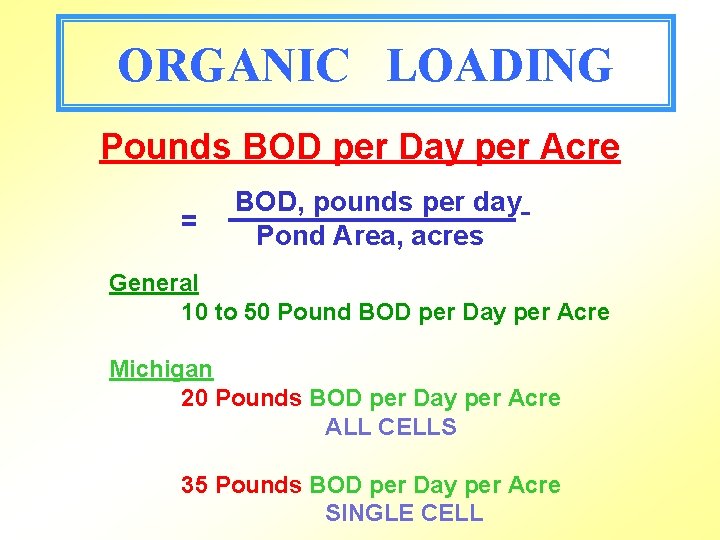
ORGANIC LOADING Pounds BOD per Day per Acre = BOD, pounds per day Pond Area, acres General 10 to 50 Pound BOD per Day per Acre Michigan 20 Pounds BOD per Day per Acre ALL CELLS 35 Pounds BOD per Day per Acre SINGLE CELL
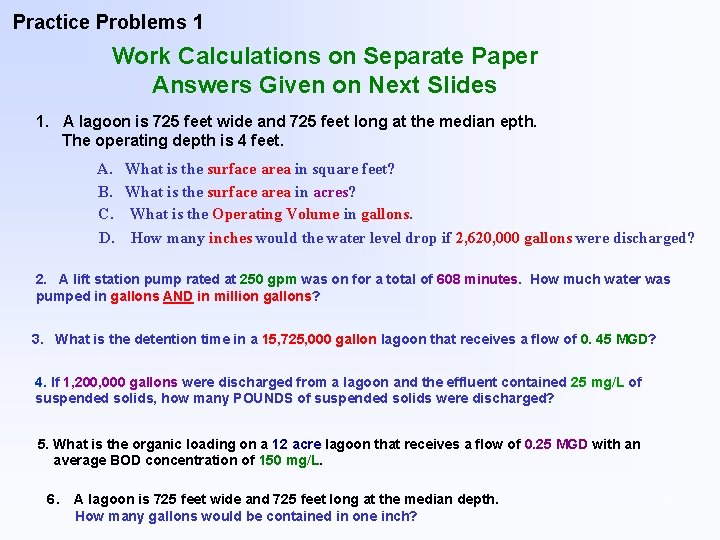
Practice Problems 1 Work Calculations on Separate Paper Answers Given on Next Slides 1. A lagoon is 725 feet wide and 725 feet long at the median epth. The operating depth is 4 feet. A. What is the surface area in square feet? B. What is the surface area in acres? C. What is the Operating Volume in gallons. D. How many inches would the water level drop if 2, 620, 000 gallons were discharged? 2. A lift station pump rated at 250 gpm was on for a total of 608 minutes. How much water was pumped in gallons AND in million gallons? 3. What is the detention time in a 15, 725, 000 gallon lagoon that receives a flow of 0. 45 MGD? 4. If 1, 200, 000 gallons were discharged from a lagoon and the effluent contained 25 mg/L of suspended solids, how many POUNDS of suspended solids were discharged? 5. What is the organic loading on a 12 acre lagoon that receives a flow of 0. 25 MGD with an average BOD concentration of 150 mg/L. 6. A lagoon is 725 feet wide and 725 feet long at the median depth. How many gallons would be contained in one inch?

Practice Problems 1 1. A lagoon is 725 feet wide and 725 feet long at the median depth. The operating depth is 4 feet. A. What is the surface area in square feet? Area = Length X Width Area = 725 ft. X 725 ft. 2 ft = 525, 625

Practice Problems 1 1. A lagoon is 725 feet wide and 725 feet long at the median depth. The operating depth is 4 feet. B. What is the surface area in acres? 1 Acre = 43, 560 ft 2 Area in Acres = Area in ft 2 43, 560 ft 2/acre 525, 625 ft 2 43, 560 ft 2/acre = 12 acre
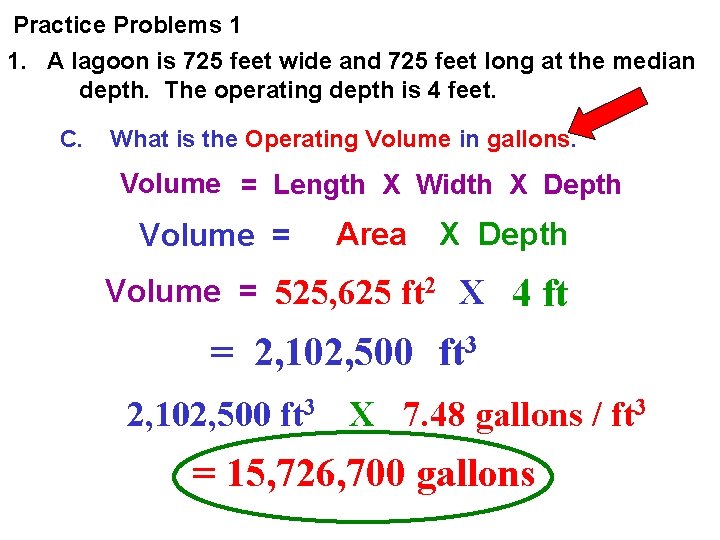
Practice Problems 1 1. A lagoon is 725 feet wide and 725 feet long at the median depth. The operating depth is 4 feet. C. What is the Operating Volume in gallons. Volume = Length X Width X Depth Volume = Area X Depth Volume = 525, 625 ft 2 X 4 ft = 2, 102, 500 ft 3 X 7. 48 gallons / ft 3 = 15, 726, 700 gallons

Practice Problems 1 1. A lagoon is 725 feet wide and 725 feet long at the median depth. The operating depth is 4 feet. D. How many inches would the water level drop if 2, 620, 000 gallons were discharged? Operating Volume = 15, 726, 700 gallons Depth = 4 feet 4 ft X 12 in = 48 inches ft gallons inch = 15, 726, 700 gallons 48 inches = 327, 640 gal/inch

Practice Problems 1 1. A lagoon is 725 feet wide and 725 feet long at the median depth. The operating depth is 4 feet. D. How many inches would the water level drop if 2, 620, 000 gallons were discharged? 2, 620, 000 gallons 327, 640 gal/inch = 8. 0 inches

Practice Problems 1 2. A lift station pump rated at 250 gpm was on for a total of 608 minutes. How much water was pumped in gallons AND in million gallons? Volume Pumped = Rate X Time gal 250 Volume Pumped = min X 608 min = 152, 000 gallons 1, 000 = 0. 152 MG
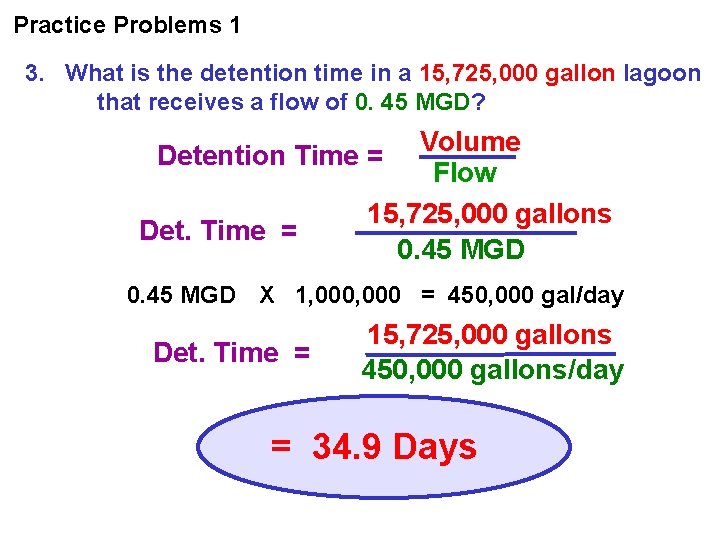
Practice Problems 1 3. What is the detention time in a 15, 725, 000 gallon lagoon that receives a flow of 0. 45 MGD? Volume Detention Time = Flow 15, 725, 000 gallons Det. Time = 0. 45 MGD X 1, 000 = 450, 000 gal/day Det. Time = 15, 725, 000 gallons 450, 000 gallons/day = 34. 9 Days
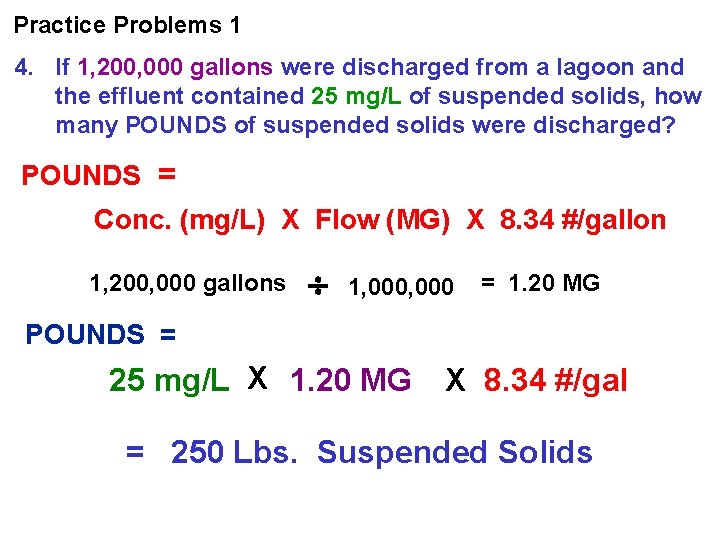
Practice Problems 1 4. If 1, 200, 000 gallons were discharged from a lagoon and the effluent contained 25 mg/L of suspended solids, how many POUNDS of suspended solids were discharged? POUNDS = Conc. (mg/L) X Flow (MG) X 8. 34 #/gallon 1, 200, 000 gallons 1, 000 = 1. 20 MG POUNDS = 25 mg/L X 1. 20 MG X 8. 34 #/gal = 250 Lbs. Suspended Solids
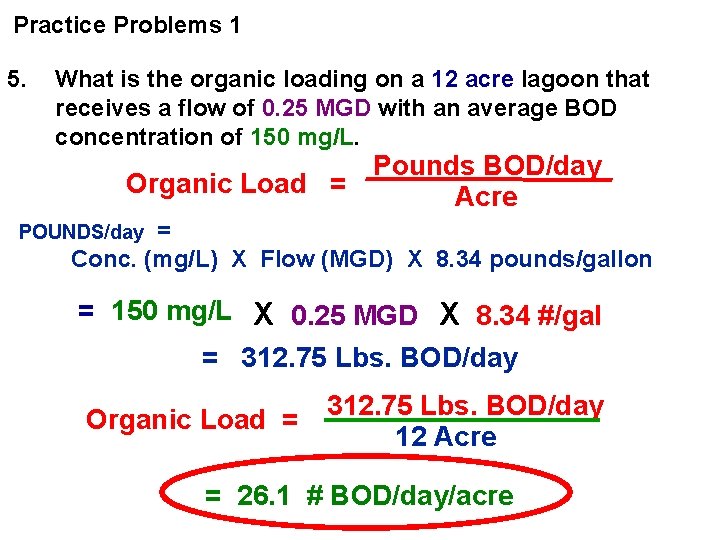
Practice Problems 1 5. What is the organic loading on a 12 acre lagoon that receives a flow of 0. 25 MGD with an average BOD concentration of 150 mg/L. Pounds BOD/day Organic Load = Acre = Conc. (mg/L) X Flow (MGD) X 8. 34 pounds/gallon POUNDS/day = 150 mg/L X 0. 25 MGD X 8. 34 #/gal = 312. 75 Lbs. BOD/day Organic Load = 312. 75 Lbs. BOD/day 12 Acre = 26. 1 # BOD/day/acre

Practice Problems 1 6. A lagoon is 725 feet wide and 725 feet long at the median depth. How many gallons would be contained in one inch? Volume = Length X Width X Depth = 1 inch Volume = 725 ft. X 1 in. 1 ft 1 in. X 12 in = 0. 0833 ft. Volume = 725 ft. X 0. 0833 ft. = 43, 785 ft 3 X 7. 48 gal/ft 3 = 327, 512 gal/inch

Practice Problems 2 Work Calculations on Separate Paper Answers Given on Next Slides • A lagoon is 525 feet wide and 250 feet long at the median depth. The operating depth is 5 feet. A. What is the surface area in square feet? B. What is the surface area in acres? C. What is the Operating Volume in gallons. D. How many inches would the water level drop if 245, 000 gallons were discharged? 2. A lift station pump rated at 325 gpm was on for a total of 647 minutes. How much water was pumped in gallons AND in million gallons? 3. What is the detention time in a 5, 250, 000 gallon lagoon that receives a flow of 0. 125 MGD? 4. If 625, 000 gallons were discharged from a lagoon and the effluent contained 23 mg/L of suspended solids, how many POUNDS of suspended solids were discharged? 5. What is the organic loading on a 9 acre lagoon that receives a flow of 0. 15 MGD with an average BOD concentration of 144 mg/L.

Practice Problems 2 1. A lagoon is 525 feet wide and 250 feet long at the median The operating depth is 5 feet. A. What is the surface area in square feet? Area = Length X Width Area = 250 ft. X 525 ft. 2 ft = 131, 250 depth.

Practice Problems 2 1. A lagoon is 525 feet wide and 250 feet long at the median The operating depth is 5 feet. B. What is the surface area in acres? 1 Acre = 43, 560 ft 2 Area in Acres = Area in ft 2 43, 560 ft 2/acre 131, 250 ft 2 43, 560 ft 2/acre = 3. 0 acre depth.
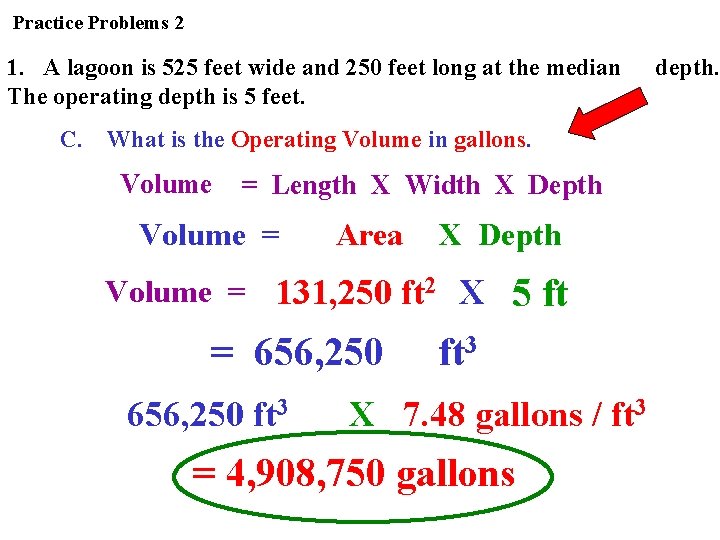
Practice Problems 2 1. A lagoon is 525 feet wide and 250 feet long at the median The operating depth is 5 feet. C. What is the Operating Volume in gallons. Volume = Length X Width X Depth Volume = Area X Depth Volume = 131, 250 ft 2 X = 656, 250 ft 3 5 ft ft 3 X 7. 48 gallons / ft 3 = 4, 908, 750 gallons depth.
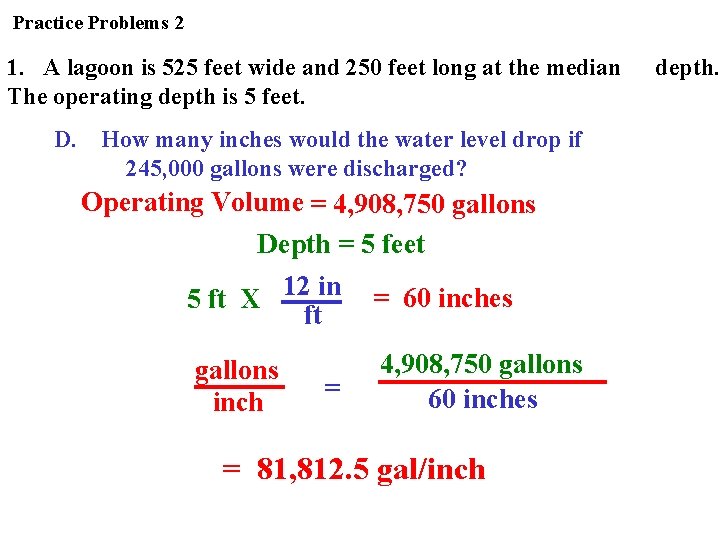
Practice Problems 2 1. A lagoon is 525 feet wide and 250 feet long at the median The operating depth is 5 feet. D. How many inches would the water level drop if 245, 000 gallons were discharged? Operating Volume = 4, 908, 750 gallons Depth = 5 feet 5 ft X 12 in ft = 60 inches gallons inch 4, 908, 750 gallons 60 inches = = 81, 812. 5 gal/inch depth.

Practice Problems 2 1. A lagoon is 525 feet wide and 250 feet long at the median The operating depth is 5 feet. D. How many inches would the water level drop if 245, 000 gallons were discharged? 245, 000 gallons 81, 812. 5 gal/inch = 3. 0 inches depth.
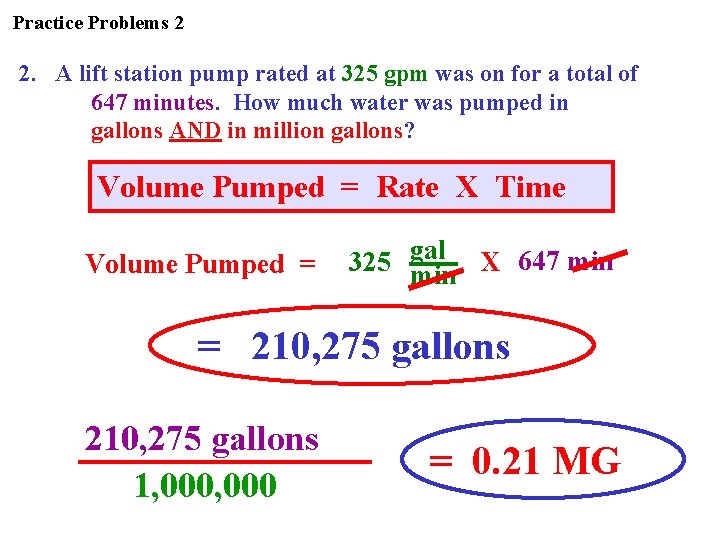
Practice Problems 2 2. A lift station pump rated at 325 gpm was on for a total of 647 minutes. How much water was pumped in gallons AND in million gallons? Volume Pumped = Rate X Time Volume Pumped = 325 gal min X 647 min = 210, 275 gallons 1, 000 = 0. 21 MG

Practice Problems 2 3. What is the detention time in a 5, 250, 000 gallon lagoon that receives a flow of 0. 125 MGD? Volume Detention Time = Flow 5, 250, 000 gallons Det. Time = 0. 125 MGD X 1, 000 Det. Time = = 125, 000 gal/day 5, 250, 000 gallons 125, 000 gallons/day = 42 Days
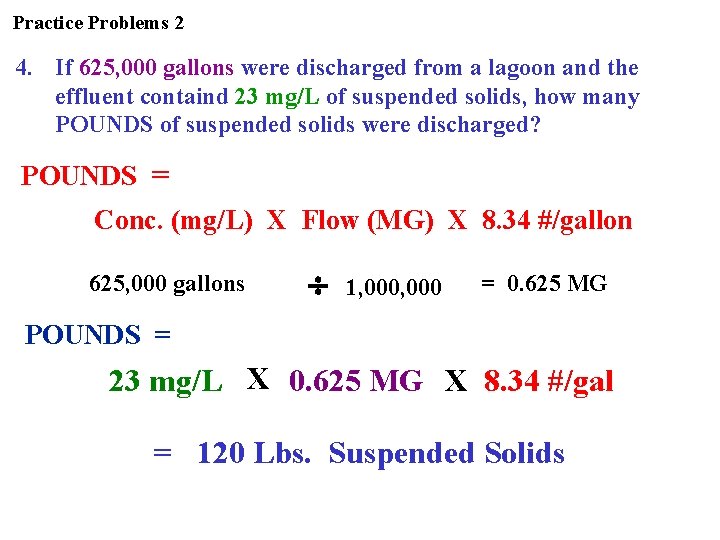
Practice Problems 2 4. If 625, 000 gallons were discharged from a lagoon and the effluent containd 23 mg/L of suspended solids, how many POUNDS of suspended solids were discharged? POUNDS = Conc. (mg/L) X Flow (MG) X 8. 34 #/gallon 625, 000 gallons 1, 000 = 0. 625 MG POUNDS = 23 mg/L X 0. 625 MG X 8. 34 #/gal = 120 Lbs. Suspended Solids

Practice Problems 2 5. What is the organic loading on a 9 acre lagoon that receives a flow of 0. 15 MGD with an average BOD concentration of 144 mg/L. Organic Load = Pounds BOD/day Acre = Conc. (mg/L) X Flow (MGD) X 8. 34 pounds/gallon POUNDS/day = 144 mg/L X 0. 15 MGD X 8. 34 #/gal = 180 Lbs. BOD/day Organic Load = 180 Lbs. BOD/day 9 Acre = 20 # BOD/day/acre

WASTEWATER STABILIZATION LAGOON PROCESS Prepared by Michigan Department of Environmental Quality Operator Training and Certification Unit
- Slides: 131